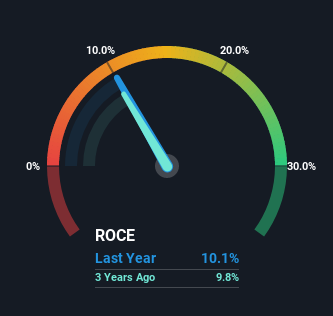Investors Met With Slowing Returns on Capital At Pernod Ricard (EPA:RI)

What are the early trends we should look for to identify a stock that could multiply in value over the long term? Firstly, we'll want to see a proven return on capital employed (ROCE) that is increasing, and secondly, an expanding base of capital employed. If you see this, it typically means it's a company with a great business model and plenty of profitable reinvestment opportunities. However, after investigating Pernod Ricard (EPA:RI), we don't think it's current trends fit the mold of a multi-bagger.
Return On Capital Employed (ROCE): What Is It?
Just to clarify if you're unsure, ROCE is a metric for evaluating how much pre-tax income (in percentage terms) a company earns on the capital invested in its business. To calculate this metric for Pernod Ricard, this is the formula:
Return on Capital Employed = Earnings Before Interest and Tax (EBIT) ÷ (Total Assets - Current Liabilities)
0.10 = €3.0b ÷ (€36b - €6.1b) (Based on the trailing twelve months to June 2022).
Thus, Pernod Ricard has an ROCE of 10%. On its own, that's a standard return, however it's much better than the 5.2% generated by the Beverage industry.
Check out our latest analysis for Pernod Ricard

In the above chart we have measured Pernod Ricard's prior ROCE against its prior performance, but the future is arguably more important. If you'd like to see what analysts are forecasting going forward, you should check out our free report for Pernod Ricard.
What Does the ROCE Trend For Pernod Ricard Tell Us?
There hasn't been much to report for Pernod Ricard's returns and its level of capital employed because both metrics have been steady for the past five years. Businesses with these traits tend to be mature and steady operations because they're past the growth phase. With that in mind, unless investment picks up again in the future, we wouldn't expect Pernod Ricard to be a multi-bagger going forward. With fewer investment opportunities, it makes sense that Pernod Ricard has been paying out a decent 49% of its earnings to shareholders. Unless businesses have highly compelling growth opportunities, they'll typically return some money to shareholders.
In Conclusion...
In summary, Pernod Ricard isn't compounding its earnings but is generating stable returns on the same amount of capital employed. Since the stock has gained an impressive 68% over the last five years, investors must think there's better things to come. However, unless these underlying trends turn more positive, we wouldn't get our hopes up too high.
Like most companies, Pernod Ricard does come with some risks, and we've found 2 warning signs that you should be aware of.
While Pernod Ricard isn't earning the highest return, check out this free list of companies that are earning high returns on equity with solid balance sheets.
New: Manage All Your Stock Portfolios in One Place
We've created the ultimate portfolio companion for stock investors, and it's free.
• Connect an unlimited number of Portfolios and see your total in one currency
• Be alerted to new Warning Signs or Risks via email or mobile
• Track the Fair Value of your stocks
Have feedback on this article? Concerned about the content? Get in touch with us directly. Alternatively, email editorial-team (at) simplywallst.com.
This article by Simply Wall St is general in nature. We provide commentary based on historical data and analyst forecasts only using an unbiased methodology and our articles are not intended to be financial advice. It does not constitute a recommendation to buy or sell any stock, and does not take account of your objectives, or your financial situation. We aim to bring you long-term focused analysis driven by fundamental data. Note that our analysis may not factor in the latest price-sensitive company announcements or qualitative material. Simply Wall St has no position in any stocks mentioned.
About ENXTPA:RI
Undervalued second-rate dividend payer.

